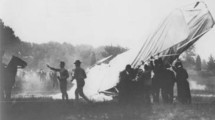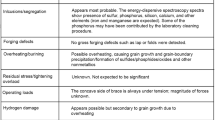Abstract
The research objective of this article is to fortify the failure mode taxonomy by including chemical failures. This inclusion would enable comprehensive risk analysis in technology-based products. As technology improves at an exponential rate, partially owing to chemical advances in the semiconductor industry, failure identification tools must keep up with the pace. While the current version of the failure mode taxonomy does consider multiple domains of failure, it does not include a comprehensive collection of chemical failures. Therefore this taxonomy is insufficient for a large number of new products. The research presented here includes identifying chemical failures from publications in the semiconductor industry. These failures were then analyzed to determine the rudimentary failure modes in each case. Finally the newly identified failure modes were added to the failure mode taxonomy. A case study is presented to demonstrate using the updated failure mode taxonomy to identify both potential failures and product risks.






Similar content being viewed by others
References
Jelinek, L.: Semiconductor industry revenue to endure slow growth in 2012. IHS iSuppli. http://www.isuppli.com/Semiconductor-Value-Chain/News/Pages/Semiconductor-Industry-Revenue-to-Endure-Slow-Growth-in-2012.aspx. Accessed 31 Jan 2012
Moore, G.: Cramming more components onto integrated circuits. Electronics 38(8), 114–117 (1965)
Okoroanyanwu, U.: Chemistry in Lithography. SPIE Press/Wiley, Bellingham (2010)
Takahashi, D.: Intel’s billion-dollar mistake: why chip flaws are so hard to fix. Venturebeat News. http://venturebeat.com/2011/01/31/intels-billion-dollar-mistake-why-chip-flaws-are-so-hard-to-fix/. Accessed 31 Jan 2011
Mack, C.: Fundamental Principles of Optical Lithography: The Science of Microfabrication. Wiley, West Sussex (2007)
Occupational Safety and Health Administration: Process Safety Management of Highly Hazardous Chemicals; Explosives and Blasting Agents; Final Rule (29 CFR 1910.119). U.S. Government Printing Office, Washington, DC (1992)
Ericson, C.: Proceedings of the 17th International Systems Safety Conference, Orlando (1999)
Wu, J.S., Apostolakis, G.E., Okrent, D.: The Analysis, Communication, and Perception of Risk. Plenum Press, New York (1991)
Kletz, T.A.: HAZOP & HAZAN Notes on the Identification and Assessment of Hazards. The Institute of Chemical Engineers, Rugby (1983)
Center for Chemical Process Safety: Guidelines for Safe Automation of Chemical Processes. Wiley-AIChE (1993)
Chrysler Corporation, Ford Motor Company and General Motors: Quality System Requirements QS-9000, 2nd edn. International Organization for Standardization (1995)
Grantham Lough, K., Stone, R., Tumer, I.: Failure prevention through effective cataloguing and utilization of historical failure events. J. Fail. Anal. Prev. 8(5), 469–481 (2008)
Grantham Lough, K., Stone, R., Tumer, I.: The risk in early design method (RED). J. Eng. Des. 20(2), 155–173 (2009)
Vesely, W.E., Goldberg, F.F., Roberts, N.H., Haasi, D.F.: The Fault Tree Handbook (NUREG 0492). U.S. Government Printing Office, Washington, DC (1981)
Kumamoto, H., Henley, E.: Probabilistic Risk Assessment and Management for Engineers and Scientists. IEEE Press, New York (1996)
O’Connor, P., Newton, D., Bromley, R.: Practical Reliability Engineering. Wiley, West Sussex (2009)
Arendt, J.S., Fussell, J.B.: System Reliability Engineering Methodology for Industrial Application. Loss Prev. 14, 18–28 (1981)
Andrews, J.D., Morgan, J.M.: Application of the digraph method of fault tree construction to process plant. Reliab. Eng. Syst. Saf. 14(2), 85–106 (1986)
Mullhia, J.S., Ang, M.L., Kelly, B.E., Less, F.P., Andrews, J.D.: The propagation of faults in process plants: fault tree synthesis for a butane vaporizer system. Reliab. Eng. Syst. Saf. 23, 31–49 (1988)
Rasmussen, N.C.: Reactor Safety Study: An Assessment of Accident Risks in US Commercial Nuclear Power Plants (NUREG-75/014). U.S. Government Printing Office, Washington, DC (1975)
Lawley, H.G.: Operability studies and hazard analysis. Chem. Eng. Prog. 70(4), 45–56 (1974)
Venkatasubramanian, V., Zhao, J., Viswanathan, S.: Intelligent systems for HAZOP analysis of complex process plants. Chem. Eng. 38(9–10), 2291–2302 (2000)
Kletz, T.A.: What went wrong?—case histories of process plant disasters, 2nd edn. Gulf Publishing, Houston (1988)
Department of Defense: Procedure for Performing a Failure Mode Effect and Criticality Analysis (MIL-P-1629). U.S. Government Printing Office, Washington, DC (1949)
National Aeronautics and Space Administration: Procedure for Failure Mode, Effects and Criticality Analysis (RA-006-013-1A). U.S. Government Printing Office, Washington, DC (1966)
Modarres, M., Kaminskiy, M., Krisvtsov, V.: Reliability and Risk Analysis a Practical Guide. CRC Press, New York (2010)
Center for Process Safety: Guidelines for Hazard Evaluation Procedures; with Worked Examples, 2nd edn. American Institute of Chemical Engineers (1992)
Andrews, J.D., Dunnett, S.J.: Event-tree analysis using binary decision diagrams. IEEE Trans. Reliab. 49(2), 230–238 (2000)
Hadipriono, F.C., Lim, C.L., Wong, K.H.: Event tree analysis to prevent failures in temporary structures. J. Constr. Eng. Manag. 112(4), 500–513 (1986)
Dowell, A.: Layer of protection analysis and inherently safer processes. Process Saf. Prog. 18(4), 214–220 (1999)
Dowell, A., Hendershot, D.: Simplified Risk Analysis-Layer of Protection Analysis (LOPA). American Institute of Chemical Engineers, Indianapolis, IN (2002)
Center for Chemical Process Safety: Layer of Protection Analysis, Simplified Process Risk Assessment. Wiley-AIChE, American Institute of Chemical Engineers, New York (2001)
Tumer, I., Stone, R., Bell, D.: Proceedings of the International Conference on Engineering Design, Stockholm (2003)
Ombete, K.: Preventing Chemical Product Failure. Masters thesis. Retrieved from the Missouri University of Science and Technology (2009)
Carr, B., Evers, A. Weimer, M. Smith, B., Leith, J.: Proceedings of the International Society for Optics and Photonics: Advanced Lithography, San Jose (2010)
Neef, C., Thomas, D.: Proceedings of the 6th International Conference on Semiconductor Technology, Shanghai (2007)
Brown, T.L., LeMay, H.E., Burseten, B.: Chemistry the Central Science, 6th edn. Prentice Hall, Englewood Cliffs (1994)
Strong, J.: Procedures in Experimental Physics. Lindsay Publications, Bradley (1938)
Xu, H., Blackwell, J.M., Younkin, T.R., Min, K.: Proceedings of the International Society for Optics and Photonics: Advanced Lithography, San Jose (2009)
Cao, H.B., Roberts, J.M., Dalin, J., Chandhok, M., Meagley, R.P., Panning, E.M., Rice, B.J.: Proceedings. EUVL Symposium, Dallas (2002)
Jurajda, D., Tenaglia, E., Jeauneau, J., Simone, D.D., Zhu, Z., Piazza, P., Piacentini, P., Canestrari, P.: Proceedings of the International Society for Optics and Photonics: Advanced Lithography, San Jose (2009)
Guerrero, D.J., Krishnamurthy, V., Sullivan, D.: Proceedings of the International Society for Optics and Photonics: Advanced Lithography, San Jose (2011)
Lowes, J., Guerrero, A., Weigand, M., Washburn, C., Stroud, C., Sharma, S., Torres, D., Slezak, M., Dabbagh, G., Tang, C.: Proceedings of the International Society for Optics and Photonics: Advanced Lithography, San Jose (2011)
Swope, M., Krishnamurthy, V., Zhu, Z., Sullivan, D., Simmons, S., Cox, C., Bennett, R., Nesbit, C.: Proceedings of the International Society for Optics and Photonics: Advanced Lithography, San Jose (2011)
Neef, C.J., Finazzo, J., Nesbit, C., Weigand, M.: Proceedings of the International Society for Optics and Photonics: Advanced Lithography, San Jose (2008)
Guerrero, D.J., Sullivan, D.M., Zhu, Z., Mercado, R.L.: Simulation and experimental study on multilayer double-patterning processes. Electrochem. Soc. Trans. 27(1), 378–473 (2010)
Lowes, J., Pham, V., Meador, J., Stroud, C., Rosas, F., Mercado, R.L., Slezak, M.: Proceedings of the International Society for Optics and Photonics: Advanced Lithography, San Jose (2010)
Guerrero, D.J., Xu, H., Mercado, R., Blackwell, J.: Underlayer designs to enhance EUV resist performance. J. Photopolym. Sci. Technol. 22(1), 117–122 (2009)
Werner, T., Steinmetz, J., Kiene, M., Eggenstein, B., Richter, F., Kahlenberg, F., Heghoyan, S., Jurajda, D., Sullivan, D.: Using soluble gap-fill materials in VFTL integration. Solid State Technol. 52(8) (2009). http://www.electroiq.com/articles/sst/2009/08/using-soluble-gap-fill-materials-in-vftlintegration.html
Turner, S.: Proceedings of the International Society for Optics and Photonics: Advanced Lithography, San Jose (2007)
Smith, B., McGarvey, S., Zhu, Z., Wang, Y., Sullivan, D.: Proceedings of the International Society for Optics and Photonics: Advanced Lithography, San Jose (2010)
Harumoto, M., Negoro, S., Hisai, A., Tanaka, M., Mori, G., Slezak, M.: Proceedings of the International Society for Optics and Photonics: Advanced Lithography, San Jose (2009)
Guerrero, D.J., Sullivan, D., Mercado, R.L.: Proceedings of the International Society for Optics and Photonics: Advanced Lithography, San Jose (2009)
Washburn, C., Evers, A., Smith, B.: Residue testing of developer-soluble bottom anti-reflective coatings. Electrochem. Soc. Trans. 18(1), 419–425 (2009)
Dalvi-Malhotra, J., Zhong, X.F., Planje, C., Brand, G., Yess, K.: A spin-on photosensitive polymeric etch protection mask for anisotropic wet etching of silicon. J. Micromechanics Microengineering 18(2), 025029-1–025029-8 (2008)
Puligadda, R., Pillalamarri, S., Hong, W., Brubaker, C., Wimplinger, M., Pargfrieder, S.: Proceedings of the Materials Research Society Symposium (2006)
Macie, J., Miranda, D., Zhu, Z., Smith, B.: Optimizing lithographic stack materials when using hyper-NA exposure tools. Solid State Technol. 52(1) (2009). http://www.electroiq.com/articles/sst/2009/01/optimizing-lithographic-stack-materials-when-using-hyper-na-exposure-tools.html
Zhu, Z., Piscani, E., Edwards, K., Smith, B.: Proceedings of the International Society for Optics and Photonics: Advanced Lithography, San Jose (2008)
Guerrero, D.J., Smith, T., Kato, M., Kimura, S., Enomoto, T.: Proceedings of the International Society for Optics and Photonics: Advanced Lithography, San Jose (2006)
Neef, C.J., Smith, B., James, C., Zhu, Z., Weigand, M.: Proceedings of the International Society for Optics and Photonics: Advanced Lithography, San Jose (2009)
Bae, Y.C., Liu, Y., Cardolaccia, T., Spizuoco, K., Bell, R., Joesten, L., Pikon, A., Reilly, M., Ablaza, S., Trefonas, P., Barclay, G.G.: Proceedings of the International Society for Optics and Photonics: Advanced Lithography, San Jose (2009)
Author information
Authors and Affiliations
Corresponding author
Rights and permissions
About this article
Cite this article
Washburn, C., Grantham, K. Chemical Failure Mode Addition to the Failure Mode Taxonomy. J Fail. Anal. and Preven. 12, 660–669 (2012). https://doi.org/10.1007/s11668-012-9603-z
Received:
Revised:
Published:
Issue Date:
DOI: https://doi.org/10.1007/s11668-012-9603-z




